
Reportage from Le Coq Sportif's France
NSS - New Sport Side
February 23rd, 2016
Romilly-sur-Seine is a small (about 14,000 inhabitants) village in the north-east of France. It is located in the Champagne Ardenne region, certainly better known for another reason. Romilly-sur-Seine can be reached by a convenient train from Gare de l'Est, in about an hour. The train passes through miles and miles of pure countryside, a landscape that can become alienating to some, or an inspiration to others.
Emile Camuset must have thought this way when, in 1882, founded here the first Le Coq Sportif factory.
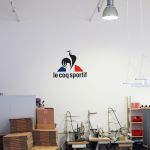
In the new headquarter in Romilly, opened 5 years ago to honor and continue the tradition of the cockerel, there is all the apparel and sportswear production of the French brand. So: the golden rooster collections - the top quality ones - and the entire Fiorentina and Saint-Etienne kit.
Everything is handmade, fait en France they say, and calculated in detail. The uniforms of the two teams have different characteristics that make them unique, the most obvious - at least for the French team - is the color. The Saint-Etienne green, become the hallmark of Le Coq extra-footballing production, was born in the '70s, when the team coached by legendary Robert Herbin becomes the first French team to reach the final of the European Cup (now Champions League ), then lost against Bayern Monaco.
But the whole history of the French brand is strictly tied hand in glove with sport, and not only with football. While Le Coq was the first brand worn by Michel Platini in his first team, Nancy, tennis also has played and important role in the spread of the brand.
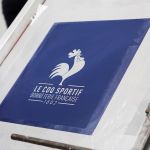
During our tour, the gentle (almost shy) product manager - speaking in his hypnotic English with French accent - shows us a piece of the new collection, inspired by the exploits of Yannick Noah, the most successful player in the history of French tennis - as well as the father of Joakim, the NBA Chicago Bulls star.
Tennis, along with cycling, is another trump card of Le Coq, one of the areas in which the brand aims to achieve the highest recognition. Today they dress Richard Gasquet, probably the most fascinating and beautiful player in the ATP. The classic tennis polo will wink again next LCS output, a miracle of elegance and appeal to tradition. In the same capsule collection (the BBR all made in France) there is also the sweatshirt tenniswear 70s, that in a close up view is even prettier than in pictures.
Traditional is also the modus operandi of the factory, based on the successful concept of experience. It takes from 2 to 5 years of training to be hired in Romilly, a period of time during which the future employees are carefully trained by the company. Human limbs that work with the precision of a robot, it might be this the sentence to summarize what we saw in our little trip. The print process is then one of those operations that remind you the beautiful color game of the childhood.
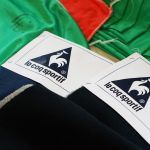
For a moment we also realize the effect the November attacks had on LCS production, but we can't tell you more. French people take exclusives very seriously, and they also hid the name of the mysterious Italian who worked on the re-issue of the most iconic of their productions, the number 10 shirt of Maradona in Mexico '86.
You can breathe so much football in that factory... From the same minds - or at least by the same company line - have passed some of the most symbolic football t-shirts ever, that marked entire generations. The one of Johan Cruyff, the one of the Olimpique Marseille become champion in Europe, or even Italy in ‘82 and Senegal in the miracles of 2002 and the French National team for the first European championship.
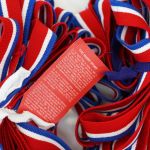
On the same morning we are lucky enough to visit also France Teintures (based in Troyes), one of the oldest dying factories in France and currently the largest in the business. Among its customers, of course, there is Le Coq Sportif. What strikes us are the high standards, the difficulty of producing something that seems elementary, such as cotton, and the myriad ways in which one thing (actually the same thing) can be done.
They actually make us understand that there is only one way to make things: well. It is difficult to understand the manufacturing and dying processes, what is most surprising is the obsessive attention to the degree of the fabrics' resistance to washing, their no shape-shifting abilities.

It is strange and curious to compare the raw materials with the finished products put on sale in the flagship store of Rue de Montmartre we visited the day before. We get there after having made a stop in the beautiful Le Coq Sportif offices in Rue Bachaumont, where the LCS team works in front of of windows overlooking the magical Parisian rooftops, from which comes a huge amount of light. After a little tour on their rooftop - one of those places that help you visualize the concept of envy - we are shown the showroom with the spring collection.
LCS will make a major breakthrough in the sneaker market, we understand, in the wake of the great success of the Arthur Ashe collection. At least three collections will become indispensable in the coming months in many European shops.
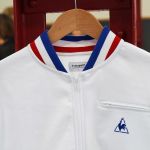
They tell us that we are lucky, just a day before Paris was gray, rainy and very cold. That morning there is instead a sun that will accompany us throughout the day, even during our trip in the town. It is obvious, every time you set foot in Paris, the phrase the enchanting Marion Cotillard pronounces in Woody Allen’s Midnight in Paris comes to your mind.
But Paris is one of the few places where you can be trivial without feeling guilty, where there is still so much beauty in the banal. That's why we walk to Montmartre, we have dinner in a bistrot and then, in the freezing cold of the capital of Europe, we get lost in the rush of a small vintage car with its capote down.








































.png)


.jpg)









.png)



